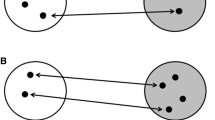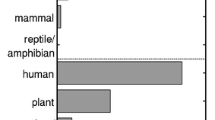Abstract
Ornithologists, and especially northern hemisphere ornithologists, have traditionally thought of migration as an annual return movement of populations between regular breeding and non-breeding grounds. Problems arise because selection does not ordinarily act on populations and because organisms of many taxa (including birds) are clearly migrants, but fail to undertake movements of the kind described. There are also extensive return movements that are not migratory. I propose that it is more useful to think of migration as a syndrome of behavioral and other traits that function together within individuals, and that such a syndrome provides a common ground across taxa from aphids to albatrosses. Large-scale return movements of populations are one outcome of the syndrome. Similar behavioral and physiological traits serve both to define migration and to provide a test for it. I use two insect (Hemipteran) examples to illustrate migratory syndromes and to demonstrate that, in many migrants, behavior and physiology correlate with life history and morphological traits to form syndromes at two levels. I then compare the two Hemipterans with migration in birds, butterflies, and fish to assess the question of whether there are migratory syndromes in common between these diverse migrants. Syndromes are more similar at the level of behavior than when morphology and life history traits are included. Recognizing syndromes leads to important evolutionary questions concerning migration strategies, trade-offs, the maintenance of genetic variance and the responses of migratory syndromes to both similar and different selective regimes.
Similar content being viewed by others
References
Able KP (1997) Review of H Dingle, migration: the biology of life on the move. Anim Behav 53:437–438
Alerstam T, Hedenström A, Åkesson S (2003) Long-distance migration: evolution and determinants. Oikos 103:247–260
Arnold GP (1981) Movements of fish in relation to water currents. In: Aidley DJ (ed) Animal migration. Cambridge University Press, Cambridge, pp 55–80
Bairlein F (2003) Nutritional strategies in migratory birds. In: Berthold P, Gwinner E, Sonnenshein E (eds) Avian migration. Springer, Berlin Heidelberg New York, pp 321–332
Berthold P, Gwinner E, Sonnenshein E (2003) Avian migration. Springer, Berlin Heidelberg New York
Böhning-Gaese K, Halbe B, Lemoine N, Oberrath R (2000) Factors influencing clutch size, number of broods and annual fecundity in North American and European birds. Evol Ecol Res 2:823–829
Bradshaw WE (1986) Pervasive themes in insect life cycle strategies. In: Taylor F, Karban R (eds) The evolution of insect life cycles. Springer, New York Berlin Heidelberg, pp 261–275
Butler PJ, Bishop CM, Woakes AJ (2003) Chasing a wild goose: posthatch growth of locomotor muscles and behavioural physiology of migration of an Arctic goose. In: Berthold P, Gwinner E, Sonnenshein E (eds) Avian migration. Springer, Berlin Heidelberg New York, pp 527–542
Carroll SP, Boyd C (1992) Host race radiation in the soapberry bug: natural history with the history. Evolution 46:1052–1069
Carroll SP, Marler M, Winchell R, Dingle H (2003) Evolution of cryptic flight morph and life history differences during host race radiation in the soapberry bug, Jadera haematoloma Herrich-Schaeffer (Hemiptera: Rhopalidae). Ann Ent Soc Am 96:135–143
Cornelius JM, Katti M, Hahn TP (2005) Temporal patterns of fat deposition, hematocrit and plumage moult in an irruptive nomad, the red crossbill Loxia curvirostra. European science foundation conference “Migration in the life-history of birds”, Wilhelmshaven Germany, Programme p 35 (Abstract)
Dingle H (1996) Migration: the biology of life on the move. Oxford University Press, New York
Dingle H (2001) The evolution of migratory syndromes in insects. In: Woiwood IP, Reynolds DR, Thomas CD (eds) Insect movement: mechanisms and consequences, CABI Publishing, Oxford, pp 159–181
Dingle H (2002) Hormonal mediation of insect life histories. In: Pfaff R et al (eds) Hormones, Brain and behavior, vol 3, Elsevier Science, New York, pp237–279
Dingle H, Winchell R (1997) Juvenile hormone as a mediator of plasticity in insect life histories. Arch Insect Biochem Physiol 35:359–373
Dingle H, Zalucki MP, Rochester WA (1999) Season-specific directional movement in migratory Australian butterflies. Aust J Entomol 38:323–329
Elliott JM (1988) Growth, size, biomass and production in contrasting populations of trout Salmo trutta in two lake district streams. J Anim Ecol 57:49–60
Fontaine M (1975) Physiological mechanisms in the migration of marine and amphihaline fish. Adv Mar Biol 13:241–355
Fraser DJ, Bernatchez L (2005) Adaptive migratory divergence among sympatric brook char populations. Evolution 59:611–624
Frazzetta T (1975) Complex adaptations in evolving populations. Sinauer, Sunderland, Mass.
Gatehouse AG (1987) Migration: a behavioural process with ecological consequences?. Antenna 11:10–12
Gwinner E, Helm B (2003) Circannual and circadian contributions to the timing of avian migration. In: Berthold P, Gwinner E, Sonnenshein E (eds) Avian migration. Springer, Berlin Heidelberg New York, pp 81–95
Hedenström A, Alerstam T, Åkesson S (eds) (2003) Ecology of long-distance movements: migration and orientation. Oikos 103:243–448
Helbig A (2003) Evolution of bird migration. In: Berthold P, Gwinner E, Sonnenshein E (eds) Avian migration. Springer, Berlin Heidelberg New York, pp 3–20
Hockey PAR, Leseberg A, Loewenthal D (2003) Dispersal and migration of juvenile African black oystercatchers Haematopus moquini. Ibis 145:512, (Electronic Ibis 145:E114–E123)
Jander R (1975) Ecological aspects of spatial orientation. Annu Rev Ecol Syst 6:171–188
Jones PJ (1989) General aspects of quelea migrations. In: Bruggers RL, Elliott CCH (eds) Quelea quelea: Africa’s bird pest. Oxford University Press, Oxford, pp 102–112
Jouventin P, Weimerskirch H (1990) Satellite tracking of wandering albatrosses. Nature 343:746–748
Kennedy JS (1966) Nervous co-ordination of instincts. Camb Res 2:29–32
Kennedy JS (1985) Migration, behavioral and ecological. In: Rankin MA (ed) Migration: mechanisms and adaptive significance. Contrib Mar Sci 27(Suppl):5–26
Kennedy JS, Booth CO (1963a) Free flight of aphids in the laboratory. J Exp Biol 40:67–85
Kennedy JS, Booth CO (1963b) Co-ordination of successive activities in an aphid The effect of flight on settling responses. J Exp Biol 40:351–369
Kennedy JS, Booth CO (1964) Co-ordination of successive activities in an aphid Depression of settling after flight. J Exp Biol 41:805–824
Kennedy JS, Ludlow AR (1974) Co-ordination of two kinds of flight activity in an aphid. J Exp Biol 61:173–196
Kennedy JS, Booth CO, Kershaw WJS (1961) Host finding by aphids in the field III Visual attraction. Ann Appl Biol 49:1–21
Ketterson ED, Nolan V Jr (1999) Adaptation, exaptation and constraint: a hormonal perspective. Am Nat 154(Suppl):S4–S25
Leisler B, Winkler H (2003) Morphological consequences of migration in passerines. In: Berthold P, Gwinner E, Sonnenshein E (eds) Avian migration. Springer, Berlin Heidelberg New York, pp 175–186
Newton I (2003) Geographical patterns in bird migration. In: Berthold P, Gwinner E, Sonnenshein E (eds) Avian migration. Springer, Berlin Heidelberg New York, pp 211–224
Newton I (2005) Stopover ecology, migration-related mortality and population limitation in birds. European science foundation conference “Migration in the life-history of birds” Wilhelmshaven, Germany, Programme p 8 (Abstract)
van Noordwijk AJ, Pulido F, Helm B, Coppack T, Delingat J, Dingle H, Hedenström A, van der Jeugd H, Marchetti C, Nilsson A, Pērez-Tris J (2006) A framework for the study of genetic variation in migratory behaviour. J Ornithol (in press)
Pulido F, Berthold P (2003) Quantitative genetic analysis of migratory behaviour. In: Berthold P, Gwinner E, Sonnenshein E (eds) Avian migration. Springer, Berlin Heidelberg New York, pp 53–77
Rankin MA (1978) Hormonal control of insect migratory behavior. In: Dingle H (eds) The evolution of insect migration and diapause. Springer, New York Berlin Heidelberg, pp 5–32
Rankin MA (1991) Endocrine effects on migration. Am Zool 31:217–230
Ricklefs RE (2000a) Lack, Skutch, and Moreau: the early development of life-history thinking. Condor 102:3–8
Ricklefs RE (2000b) Density dependence, evolutionary optimization, and the diversification of avian life-histories. Condor 102:9–22
Roff D (1991) Life history consequences of bioenergetic and biomechanical constraints on migration. Am Zool 31:205–215
Schaefer T, Pulido F (2005) Clutch size determination in short-distance and long-distance migrants. European science foundation conference “Migration in the life-history of birds” Wilhelmshaven Germany, Programme p 46 (Abstract)
Schaffer WM, Elson PF (1975) The adaptive significance of variations in life history among local populations of Atlantic salmon in North America. Ecology 56:577–590
Sih A, Bell AM, Johnson JC, Ziemba RE (2004) Behavioral syndromes: an integrative overview. Q Rev Biol 79:241–277
Slansky F (1980) Food consumption and reproduction as affected by tethered flight in female milkweed bugs (Oncopeltus fasciatus). Entomol Exp Appl 28:277–286
Snyder RJ, Dingle H (1989) Adaptive, genetically based differences in life history between estuary and freshwater threespine sticklebacks (Gasterosteus aculeatus L). Can J Zool 67:2448–2454
Spieth HR, Cordes R-G, Dorka M (1998) Flight directions in the migratory butterfly Pieris brassicae: results from semi-natural experiments. Ethology 104:339–352
Srygley RB, Oliveira EG (2001) Orientation mechanisms and migration strategies within the flight boundary layer. In: Woiwood IP, Reynolds DR, Thomas CD (eds) Insect movement: mechanisms and consequences. CABI Publishing, Oxford, pp 183–206
Winchell R, Dingle H, Moyes CD (2000) Enzyme profiles in two wing polymorphic soapberry bug populations (Jadera haematoloma Rhoplaidae). J Insect Physiol 46:1365–1373
Wingfield JC (2003) Avian migration: regulation of facultative-type movements. In: Berthold P, Gwinner G, Sonnenshein E (eds) Avian migration. Springer, Berlin Heidelberg New York, pp 113–125
Zera AJ, Denno RF (1997) Physiology and ecology of dispersal polymorphism in insects. Annu Rev Entomol 42:207–231
Acknowledgments
This paper is based on a plenary talk at the European Science Foundation conference on ‘Migration in the life-history of birds’ in Wilhelmshaven, Germany in February 2005. I am grateful to Franz Bairlein for the invitation to speak and to the ESF for travel support to attend. Scott Carroll provided much background information and valuable discussion on soapberry bugs and read the first draft of the manuscript. Thoughtful and detailed comments by Alistair Drake did much to clarify and improve the final version. My own research on migration has been supported by the US National Science Foundation and by an Alexander v. Humboldt Senior Scientist Award at the Vogelwarte Radolfzell hosted by Peter Berthold.
Author information
Authors and Affiliations
Corresponding author
Additional information
Communicated by F. Bairlein
Rights and permissions
About this article
Cite this article
Dingle, H. Animal migration: is there a common migratory syndrome?. J Ornithol 147, 212–220 (2006). https://doi.org/10.1007/s10336-005-0052-2
Received:
Revised:
Accepted:
Published:
Issue Date:
DOI: https://doi.org/10.1007/s10336-005-0052-2




